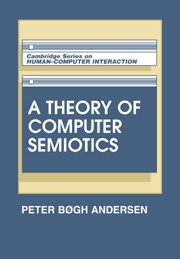 A Theory of Computer Semiotics
A Theory of Computer Semiotics I.1 - The structuralist heritage
Published online by Cambridge University Press: 26 March 2010
Summary
I start with a reassessment of selected linguistic traditions. Since they were developed to meet needs other than those I want them to serve, a careful reexamination is not out of place.
Empirical characteristics of two work languages
The first issue I shall take up is simply whether they are able to handle the language variety in which most computer systems must function, namely the languages of people at work, and in order to do so we need to know what a “work language” is.
The car repair shop
The typical Danish car repair shop is a small scale enterprise, consisting of the owner and a couple of skilled workers, possibly an apprentice and a bookkeeper, as well.
Most of the work can be performed by one worker alone, so cooperation is seldom a physical necessity. Planning and execution of the work procedure is integrated. The mechanic performs both tasks. Personal relationships between employer and employee survive, such as the master-journeyman relationship. Normally, a small stock of tools is used: hammers, screwdrivers, nippers, etc.
In the early eighties, I investigated communication in a small repair shop, and the following pages are based on this project. The research was done in collaboration with one of the mechanics employed in the garage. A taperecorder placed on a bench recorded the conversation that took place during work. (Everybody in the garage knew about the recording.) The mechanic also produced written descriptions of whole working days.
The analysis of the data took 1 1/2 years. The mechanic was employed as an assistant teacher in an advanced course at the university.
- Type
- Chapter
- Information
- A Theory of Computer SemioticsSemiotic Approaches to Construction and Assessment of Computer Systems, pp. 29 - 74Publisher: Cambridge University PressPrint publication year: 1991


